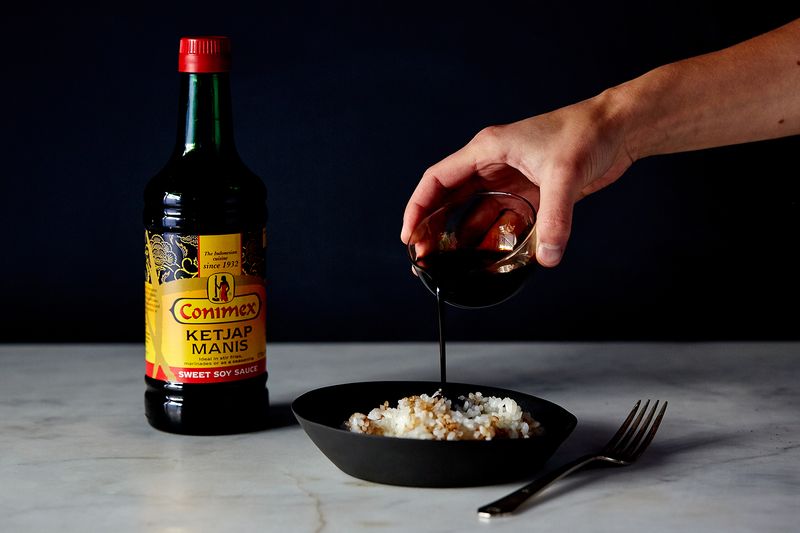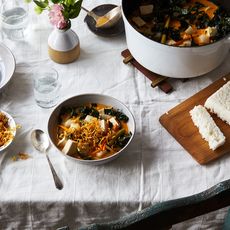When I got married, my mom gave me a notebook filled with favorite recipes from my childhood. In her flamboyant script—adorned with swirls, curls, and a mother’s love—she wrote down recipes for ayam goreng kuning (fried turmeric chicken), kroket kentang (potato croquettes), sop buntut (oxtail soup), and many, many more.
Over the years, I’ve pulled it out often, scouring the pages to supplement my taste memories. Like the time I craved Mom’s fried steak blanketed in a special sauce that was as elusive as wild strawberries in winter. Was the velvety sauce jazzed up with nutmeg or coriander? Did the sweetness come from kecap manis (sweet soy sauce)? I had only to flip to the recipe to find the answers.
On the other hand, I also read through the recipes just for fun, practicing my poor grasp of Indonesian, and skipping down memory lane to the outdoor kitchen where Mom cooked her most pungent dishes.

by Sarah Jampel
When I was developing recipes for my latest cookbook, I recalled a dish Mom made—sayur lodeh (vegetables stewed in coconut milk). Traditionally, everything from chayote, young jackfruit, and eggplant, to long beans and petai (stink beans) can go into sayur lodeh.
In Indonesia (and Singapore and Malaysia), the stew is usually served with boiled rice cakes instead of steamed rice. The rice cakes can take two forms—diamond-shaped (ketupat) or cylindrical (lontong). Both are wrapped in leaves. Ketupat is wrapped in woven coconut leaf pouches and the latter, in banana leaves. To eat, the leaves are removed and the rice cakes cut into smaller pieces.
Sayur lodeh is one of those foods, like cupcakes, that easily flits between everyday and festive. Some people may enjoy it for breakfast, while others will serve it at big celebrations like weddings, birthdays, and Lebaran (the Indonesian equivalent of Eid). Mom would serve it as a side dish for dinner or as part of a festive meal to celebrate the 15th day of the Lunar New Year. The spread, collectively dubbed Lontong Cap Go Meh (lontong for the 15th day), comprised said lontong and sayur lodeh, plus opor ayam (chicken braised in coconut milk), sambal goreng ati (spicy liver), pindang telur (soy sauce eggs), and more.

To my surprise, Mom’s sayur lodeh recipe wasn’t in the book. I scrutinized it from cover to cover, willing the recipe to appear on the blank pages in the back. Then it came to me—fussy five-year-old me (and probably older me too!) didn’t like this dish. Mom must have remembered and left it out deliberately.
Though I was disappointed, I was both touched and relieved. Touched that Mom still remembered this little detail after all these years; relieved because since I wasn’t using her recipe, I could improvise with abandon and none of the guilt.
And improvise, I did.
White Curry Soup with Pressed Rice Cakes
White Curry Soup
-
2
fresh long red chilies like Fresno or cayenne, or 2 tablespoons chili paste like sambal oelek -
3
cloves garlic -
3
ounces shallots, peeled and roughly chopped -
1/2
tablespoon peeled and roughly chopped fresh ginger -
1
teaspoon ground coriander -
2
tablespoons vegetable oil -
2
cups unsweetened coconut milk -
2
cups water -
8
ounces chayote or zucchini, peeled and cut into 1-inch matchsticks -
1
small turnip, peeled and cut into 1-inch cubes -
2
medium carrots, peeled and cut into 3-inch matchsticks -
4
ounces green beans, trimmed and cut into 2-inch lengths -
4
ounces firm tofu or tempeh, cut into 1-inch cubes -
1-inch piece fresh galangal, cut into coins
-
6
ounces lacinato kale or other hearty green vegetable, shredded -
1
teaspoon fine sea salt -
1/2
teaspoon freshly ground black pepper -
1/2
teaspoon granulated sugar -
Fried shallots for garnish
Pressed Rice Cakes
-
1
cup uncooked jasmine rice -
2
cups water -
banana leaves, defrosted if frozen (optional)
(via Food52)






